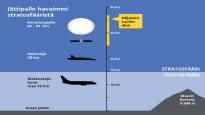The suspected spy ball could have collected electromagnetic radiation or tested the US air defense system, security experts estimate.
Annika Martikainen
Joonatan Reunanen
Maija Hurme
Nanna Särkkä
China’s suspected spy ball may have been a “point-of-sight” that has been supplemented by satellite intelligence. This is what a university lecturer thinks Jyrki Isokangas from the University of Jyväskylä.
– Even if the ball has lower quality sensors, it is able to stay on one target longer than satellites, says Isokangas.
The United States shot a Chinese weather balloon into the sea on Saturday, which it suspects is being used for espionage. China has denied the allegations of espionage. Another ball of the same type has been spotted in recent days in South America.
Security expert Jukka Savolainen speculates that the sphere may have been used to collect electromagnetic radiation or measure magnetic fields. Collecting electromagnetic radiation would mean, for example, monitoring phone calls. This data is collected from a lower altitude than the data collected by satellites, so the ball would have been at the correct altitudes.
Savolainen is on unpaid leave from the position of Network Director of the Hybrid Skills Center because he is a candidate for parliament from the coalition’s list in Varsinais-Suomi.
Not a very effective intelligence system
University lecturer Isokangas thinks it is possible that the weather balloon has a laser imaging or laser scanning system. A SAR radar, i.e. a synthetic aperture radar, can also be included. The United States has its own sensors on the ground to detect the use of such devices.
In laser bowling, laser beams of different frequencies are sent to the target and they are reflected back, drawing an image of the target. SAR radar can be used to shoot in the dark and in any weather.
According to Isokanka, the weather balloon is not a very effective or easy-to-use intelligence system because it is difficult to control. It is possible that China is testing how sensitively the US air defense system reacts to aircraft.
International agreements do not specify the exact height where each state’s airspace ends and space begins. However, according to Savolainen, the Chinese ball flew so low that it was undoubtedly an airspace violation and the United States had the right to shoot it down.
China had the entire Pacific to take the ball down
Head of the Finnish Meteorological Institute’s Arctic Space Center unit Jyri Heilimon based on the images in the media, the need for the ball’s power has probably been high, because the solar panels are large, up to tens of square meters.
The devices have consumed a lot of electricity. Such devices are often signal-transmitting devices, rather than imaging or receiving devices, for example, and they probably weighed between 1000 and 2000 kilograms.
Heilimo says that it would be an atmospheric satellite, more precisely HAPS (High-altitude pseudo satellite). They can be not only balls but also airships or unmanned aircraft.
HAPS satellites are placed in the quiet wind region at an altitude of 20 to 35 km so that they can be steered. When the pressure of the ball is adjusted, it is brought to the desired flows, so that the ball is guided where desired.
The footage obtained by the ball could have been significantly more accurate than that of reconnaissance satellites.
Heilimo says that intelligence satellites are usually at an altitude of about 400 kilometers. The accuracy or resolution of these satellite images is about 30 centimeters – that is, the image consists of 30-centimeter squares.
According to Heilimo, it is possible that the ball could have had a camera similar to that in satellites at an altitude of 400 kilometers.
In Heilimo’s opinion, the ball traveled a surprisingly long distance. For comparison, for example, a research balloon was sent from Kiruna, Sweden, which eventually landed in Lapland, Finland.
Heilimo thinks that the ball sent by China might also have been a research ball whose landing mechanism broke. After all, China had the entire Pacific Ocean to take the ball down.
A similar HAPS ball flies in South America. Heilimo considers it unlikely that the mechanism was broken in both.
